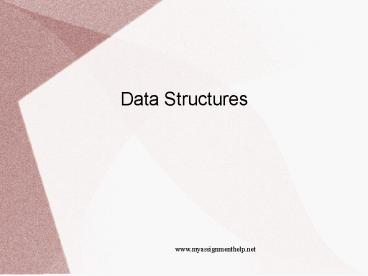Learn Data Structures With Myassignmenthelp.Net - PowerPoint PPT Presentation
Title:
Learn Data Structures With Myassignmenthelp.Net
Description:
Data Structures is an Integrated and most Important part of the programming. Every Programmer should have a knowledge of data structure in order to be a successfull programmer. So for the convenience of the programming aspirants www.myassignmenthelp.net offers an Online Tutoring and Online Assignment Help where Anyone who wants to learn data structures or wants to get their problem solved can send their request and myassignmenthelp.net will provide the solutions before the deadline given. – PowerPoint PPT presentation
Number of Views:68
Title: Learn Data Structures With Myassignmenthelp.Net
1
Data Structures
2
Introduction
- Data Structure is a way to store and organize
data in the structured manner. Computer's memory
is divided into small parts, we use different
data structures to store data in those small
blocks. Example Arrays, Linked list, Trees etc - A means of storing a collection of data.
3
algorithm
- A systematic method of instructing an agent how
to accomplish a task. - Usually expressed in a step-wise sequential form.
- May involve alternation, iteration or recursion
- Detail and language may depend on the agent
4
Data structure and algorithm Algorithms are part
of what constitutes a data structures. In
constructing a solution to a problem, a data
structure must be chosen that allows the data to
be operated upon easily in the manner required by
the algorithm. In conclusion Data Structures
Algorithm Program
5
Application of data structure
- Stack Application
- Direct Application
- Page-visited history in a Web Browser
- Undo sequence in a text editor
- Chain of method calls in the Java Virtual Machine
or C runtime environment. - Indirect Application
- Auxiliary data structure for algorithm
- component of other data structure
6
Application of data structure
- Queue Applications
- Direct Application
- Waiting lines
- Access to shared resources (e.g printer)
- Multiprogramming
- Indirect Application
- Auxiliary data structure for algorithms
- Component of other data structure
7
Classification of data structure
- Linear
- In Linear Data Structure, the data items are
arranged in linear sequence. e.g. Array, Stack,
Queue, Linked List. - Non-Linear
- In Non-Linear Data items are not in sequence.
e.g. Tree, Graph, Heap.
8
Classification of data structure
- Homogeneous
- In Homogenous data structure, all the elements
are of same type e.g. Array - Non-Homogenous
- In Non-Homogenous data structure, the elements
may or may not be of same type e.g. Record.
9
Arrays
- Array is basic data structure in which we store
data in continues memory locations. - Array is variable which holds multiple elements
of same type - Arrays reduce the redundancy
- Generic form of arrays
- data type array_namesize
- Data type what type of data(int, float, char...)
- Size number elements you want to store
- Disadvantages
- Capable of holding only one type of elements.
- Insertion and deletion is very difficult
- Waste of memory is very high
10
Linked list
- Linked List
- Collection of nodes which or connected together
- Node
- Is just like variable but it holds data and
address of the next node or null - When linked list is useful
- Do not know the number of data elements
- Your list need to be sorted quickly
11
Linked list
- Advantages
- Memory efficiency is very high
- Insertion and deletion is very easy and fast
- Disadvantages
- Traversal is very slow
- If you want to access 10th element in the list
you need to cross 9 elements (arrays are very
fast because of index) - You can move only in one direction in single
linked list - If one link is corrupted remain data will be lost
12
Double Linked list
- In single linked we can move only in one
direction - Double linked list allow us to move in direction.
- Double linked is also collection of nodes, but
here node is contains more than 2 fields. - Node one field holds data, second field holds
address of next node or null and third field
holds address of previous node or null.
13
Double Linked list
- Disadvantages
- Need extra space for holding references
- Still it is very slow to travel across the list
- Circular linked list
- If the head of linked list is connected to tail
that listis called circular linked list. - Application of linked list
- Stacks and Queues.
14
Stack
- Stack
- New nodes can be added and removed only at the
top - Similar to a pile of dishes
- Last-in, first-out (LIFO)
- Bottom of stack indicated by a link member to
NULL - Constrained version of a linked list
15
- Operations on Stack
- Push
- Adds a new node to the top of the stack
- Pop
- Removes a node from the top
- Stores the popped value
- Returns true if pop was successful
16
Queue
- Queue
- Similar to a supermarket checkout line
- First-in, first-out (FIFO)
- Nodes are removed only from the head
- Nodes are inserted only at the tail
- Insert and remove operations
- Enqueue (insert) and dequeue (remove)
17
Thank
You

